|
|
|
| |
|
||||
|
|
Harvesting
in Later Years. |
||
|
From the earliest times the sickle was the only
means The next major leap was the binder, this was essentially a reaper with a table behind the blade, this table had a canvas conveyer belt which took the cut stalks across to another conveyer, which raised them to a platform where they were tied mechanically with 'binder twine' into sheaves and thrown out the side of the binder. The sheaves were then gathered and made into stook's. The power for the reaper was taken from two cast iron wheels, the binder was generally driven by a single fabricated steel wheel, both machines only worked when the horses moved forward. After the introduction of the motor tractor many of these machines were converted to be pulled by a tractor, and were in use in remoter areas of Ireland up until the 1960's. The video below shows a binder pulled by a tractor. Haymaking at Trim County Meath. The arrival of the age of steam revolutionized
the harvesting of grain crops, The video below shows a variety of threshers, the baler is a pick up and was not developed until after the development of the combine harvester, which it followed and baled the straw into rectangular bales. The grain emerged from the rear of the thresher were it was bagged, these bags often weighed as much as two hundred weight 102 Kg (224 Lbs) The stalks were carried through the thresher and emerged at the top of the other end, where it fell into the baler, the baler as its name implies formed the stalks into oblong bales which were tied with baler twine. When the motor tractor came into use in the early years of the 20th century, they replaced the steam traction engines. Which can occasionally be seen at vintage rallies. The combine harvester began to be used in the late 1950's, it both cut and threshed the crop, holding the grain in a storage tank, which when full was discharged into a trailer, the straw emerged from the back of the combine onto the ground, where it was later baled with a pick-up bailer. The first combines were trailed 'Pulled and powered by a tractor' later they were self propelled, today's combines may have engines of two hundred horsepower and are capable of harvesting 60 acres a day. |
||
|
|
The
Potato. |
||
|
The potato was introduced to Ireland from south America in the mid 1500's by Sir Walter Raleigh, it was first grown at Killua Castle in Westmeath where a obelisk commemorates the event. After the initial introduction it was grown in small quantities mainly in Munster. Farmers soon realized if they grew potatoes they would have enough to eat and would consequently have more grain, and possibly some potatoes to sell. By the mid eighteenth century the potato had New varieties of potatoes were being introduced, the Apple Potato around 1760, the Cup Potato about 1800, and in 1810 the Lumper Potato was introduced, it proved to to be able to tolerate poorer soils with little manure, and quickly spread across the country. The burgeoning population of Dublin and other city's were creating a demand for potato's which the farmers were quick to supply. By the early 1800's the population of Ireland had grown to almost eight million, by 1830 some 30% to 34% of the population depended on the potato entirely for survival. In the early 1700's people in the west of Ireland would have had one meal of potatoes a day, by 1800 it had grown to two and by 1840's people would have eaten three potato meals a day amounting to about five kilos (11 lb.). This almost total reliance on potatoes is the main reason for the devastating consequences when the potato blight struck Ireland in 1845, resulting in famine. |
||
|
|

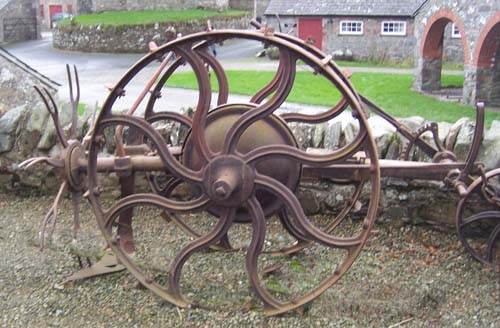
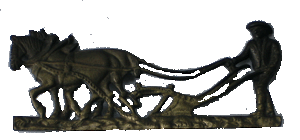 of the
land, grass grows particularly well especially in midland counties
around Westmeath, which are famed for their production of beef cattle.
Before the introduction of the potato in the mid fifteen hundreds
by
of the
land, grass grows particularly well especially in midland counties
around Westmeath, which are famed for their production of beef cattle.
Before the introduction of the potato in the mid fifteen hundreds
by 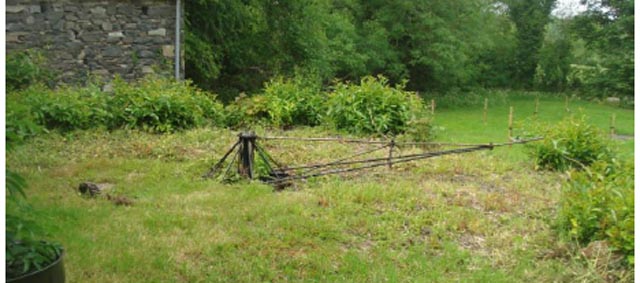 little less than
300 mm (12 inches) in diameter from this you took a handful and
wrapped it around the waist of the sheave like a belt, you twisted
the two ends together and tucked it from the top under the belt.
Four sheaves were then taken and propped against each other to form
a stook. The crop was left like this for a period of time to dry.
little less than
300 mm (12 inches) in diameter from this you took a handful and
wrapped it around the waist of the sheave like a belt, you twisted
the two ends together and tucked it from the top under the belt.
Four sheaves were then taken and propped against each other to form
a stook. The crop was left like this for a period of time to dry. stage
depended on the the tradition of the locality or the preference
of the farmer. Often the stook's were built into Bart's or Rucks
'Round stacks with rounded conical tops' (Different names applied
depending on the locality.) Usually these were built on a bed of
whin's (Gorse) which would be arranged in a circle about twice the
height of the crop in diameter, this kept the crop off the ground,
the center of this would be higher than the outside, the sheaves
were then placed with the heads to the center and arranged in a
circle. A cry often heard from the farmer during this operation
was "Keep your heart up" referring to the main object
of keeping an outward slope on the sheave to shed the rain. Sometimes
the stook's were taken directly to the haggard 'Hay yard' and built
into Bart's or larger stacks there, from where it was more convenient
for threshing.
stage
depended on the the tradition of the locality or the preference
of the farmer. Often the stook's were built into Bart's or Rucks
'Round stacks with rounded conical tops' (Different names applied
depending on the locality.) Usually these were built on a bed of
whin's (Gorse) which would be arranged in a circle about twice the
height of the crop in diameter, this kept the crop off the ground,
the center of this would be higher than the outside, the sheaves
were then placed with the heads to the center and arranged in a
circle. A cry often heard from the farmer during this operation
was "Keep your heart up" referring to the main object
of keeping an outward slope on the sheave to shed the rain. Sometimes
the stook's were taken directly to the haggard 'Hay yard' and built
into Bart's or larger stacks there, from where it was more convenient
for threshing.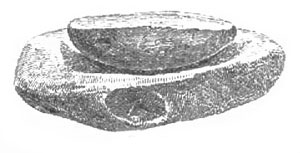 achieved
with a flail this consisted usually of two wooden pole's joined
with a piece of chain or a piece of stout leather, the handle was
stouter and longer than the flail, The crop was laid on a piece
of canvas or sacking and beaten with the flail, a breezy day was
preferable for this operation as the wind blew the chaff away. Some
farmers had buildings with a door in each side for this very purpose,
many of these buildings are still to be seen in old farmyards throughout
the country. Threshing could also be achieved by taking a handful
of stalks by the base and bearing the heads over a solid object.
It was probably not until the early to mid 1800's that threshing
was mechanized and then only on the larger more progressive farms
and estates.
achieved
with a flail this consisted usually of two wooden pole's joined
with a piece of chain or a piece of stout leather, the handle was
stouter and longer than the flail, The crop was laid on a piece
of canvas or sacking and beaten with the flail, a breezy day was
preferable for this operation as the wind blew the chaff away. Some
farmers had buildings with a door in each side for this very purpose,
many of these buildings are still to be seen in old farmyards throughout
the country. Threshing could also be achieved by taking a handful
of stalks by the base and bearing the heads over a solid object.
It was probably not until the early to mid 1800's that threshing
was mechanized and then only on the larger more progressive farms
and estates. 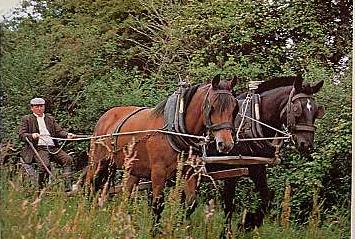 of
cutting crops, eventually the scythe was developed enabling a man to cut
a larger area in a day. With the advent of the industrial revolution many
labour saving devises were designed for the farm, the horse reaper illustrated
on the left, is cutting a crop of hay, with it one man and a pair of horses
could do the work which would have previously employed many men. The reaper
simply cut the crop, it still had to be tied into sheaves and stooked,
(From 'Stuaic' pointy pinnacle) this consisted of standing four sheaves
against each other and tying the tops together with a handful of the stalks.
of
cutting crops, eventually the scythe was developed enabling a man to cut
a larger area in a day. With the advent of the industrial revolution many
labour saving devises were designed for the farm, the horse reaper illustrated
on the left, is cutting a crop of hay, with it one man and a pair of horses
could do the work which would have previously employed many men. The reaper
simply cut the crop, it still had to be tied into sheaves and stooked,
(From 'Stuaic' pointy pinnacle) this consisted of standing four sheaves
against each other and tying the tops together with a handful of the stalks.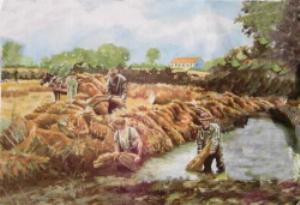
 acclimatized to Ireland and its use spread into Connacht and Leinster,
it was in the former that the lazy bed was invented, in Leinster it became
the staple diet of the farm laborer's. Potatoes have one main disadvantage
in that they don't store well for longer than nine months, this leaves
a lean period, the so called 'hungry month's' of June and July this was
the time some of the pigs would either have been sold or killed and eaten.
Another lesser problem was that being bulky they were difficult to transport,
and consequently developed as a subsistence crop, the exception being
near large areas of population such as the major city's and town's.
acclimatized to Ireland and its use spread into Connacht and Leinster,
it was in the former that the lazy bed was invented, in Leinster it became
the staple diet of the farm laborer's. Potatoes have one main disadvantage
in that they don't store well for longer than nine months, this leaves
a lean period, the so called 'hungry month's' of June and July this was
the time some of the pigs would either have been sold or killed and eaten.
Another lesser problem was that being bulky they were difficult to transport,
and consequently developed as a subsistence crop, the exception being
near large areas of population such as the major city's and town's.